|
|



Your search for articles published in volume 10 has found 30 articles.
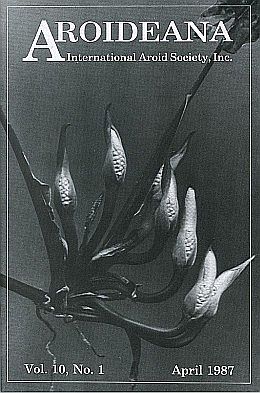
| 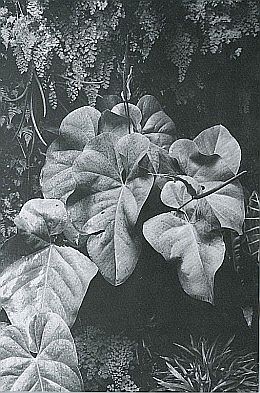
|

| 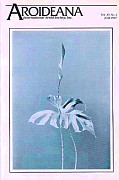
| 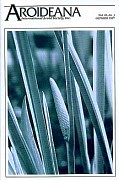
| 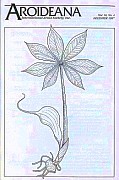
|
Articles of 3 pages or less are available for free to IAS members for download, and longer articles for $5. Articles from issues in 2016 and beyond are only available electronically, and are free to current members when they are logged in.
Please remember that all Aroideana articles are protected by copyright, and you may NOT distribute even electronic copies without permission from the authors or editor.
(Issue) |
||||
| Anonymous | Errata
This article available FREE to IAS Members with a PERSONAL login. LOGIN, REGISTER or JOIN | |||
| John Banta | Photograph: Spathicarpa sagittifolia var. Gardnerii
This article available FREE to IAS Members with a PERSONAL login. LOGIN, REGISTER or JOIN | |||
| Peter C. Boyce | A new species of Arum L. from Crete
This article available FREE to IAS Members with a PERSONAL login. LOGIN, REGISTER or JOIN | |||
| ABSTRACT: Arum purpureospathum Boyce sp. nov. is described. | ||||
| Honora Murphy | The Araceae treatment in the Flora of Tropical East Africa
This article available FREE to IAS Members with a PERSONAL login. LOGIN, REGISTER or JOIN | |||
| ABSTRACT: Simon Mayo's recent treatment of the Araceae for the Flora of Tropical East Aftica, (R.M. Polhill, ed., Dec. 1985) is reviewed. | ||||
| Peter Matthews | Wild taro and the context of cultivation (Buy) | |||
| ABSTRACT: Two historical questions of primary importance are, first, what was the natural distribution range of taro before its use by humans? Secondly, in what areas has cultivation of local indigenous taro taken place? The present distribution of taro is the outcome of selection and transfer by humans, as well as natural selection dispersal. | ||||
| James B. Watson | Anthuriums for south Florida gardens (Buy) | |||
| ABSTRACT: At a time when we are searching for new dimensions in plant design, anthuriums have been discovered to add excitement to our predictable landscape designs. | ||||
| Thomas B. Croat, Josef Bogner | Aroid profile no. 11: Syngonium steyermarkii Croat
This article available FREE to IAS Members with a PERSONAL login. LOGIN, REGISTER or JOIN | |||
| ABSTRACT: Syngonium steyermarkii Croat is endemic to the Pacific slope of Guatemala and Southern Mexico at elevations above 1100 m. It was first collected by Dr. Julian Steyermark (Missouri Botanical Garden), who made three sterile collections of the species in three different Departments of Guatemala (Quezaltenango, San Marcos, and Suchitepequez) while collecting for the Field Museum in 1941 and 1942. | ||||
| Joe Wright | Queries
This article available FREE to IAS Members with a PERSONAL login. LOGIN, REGISTER or JOIN | |||
| ABSTRACT: Two questions on Amorphophallus hardiness and dormancy are answered. | ||||
| Anonymous | Tentative international register of Anthurium hybrids A tentative check list
This article available FREE to IAS Members with a PERSONAL login. LOGIN, REGISTER or JOIN | |||
| ABSTRACT: The Registration Committee for the International Aroid Society presents a compilation of all known published hybrids in the genus Anthurium. | ||||
| Josef Bogner | Morphological variation in aroids (Buy) | |||
| ABSTRACT: The Araceae or aroid., are a large family of about 2400 species, grouped in 107 genera and these again in nine subfamilies. The aroids are mainly a tropical family and are distributed world-wide. They show great variation in their morphological characters, which will be described in this paper along with some other data. | ||||
| John Banta | Photography: Amorphophallus paeoniifolius (Dennst.) Nicolson
This article available FREE to IAS Members with a PERSONAL login. LOGIN, REGISTER or JOIN | |||
| R. Hegnauer | Phytochemistry and Chemotaxonomy of the Araceae
This article available FREE to IAS Members with a PERSONAL login. LOGIN, REGISTER or JOIN | |||
| ABSTRACT: Many Aroids taste painfully acrid and are toxic. Nevertheless the family yields a number of tropical food crops and many ornamental plants. Phytochemistry and chemotaxonomy of Aroids is discussed. | ||||
| Joe Wright | Queries
This article available FREE to IAS Members with a PERSONAL login. LOGIN, REGISTER or JOIN | |||
| ABSTRACT: Aglaonema rotundifolia defies all my attempts to grow this beautiful plant. | ||||
| Craig Phillips | Aroid profile no. 12: Monstera oblique
This article available FREE to IAS Members with a PERSONAL login. LOGIN, REGISTER or JOIN | |||
| ABSTRACT: A small but attractive vine, Monstera obliqua is one of the more commonly cultivated monstera., at the present time. The nearly uniform appearance ofhorticulturally available plant., with their leaves highly perforated and looking as if they descended from a common ancestral clone belies the fact that in nature M.obliqua is a highly variable plant leafwise, both in size, shape, and hole pattern when present. | ||||
| Li Hen | What is Gonatanthus (?) ornatus Schott (Araceae) (Buy) | |||
| ABSTRACT: Remusatia ornata H. Li et G. F. Guo, comb. nov. is described. | ||||
| Josef Bogner | A new Typhonium species from Thailand (Buy) | |||
| ABSTRACT: Typhonium albispathum Bogner, spec. nov. is described. | ||||
| Marilyn Johnson | Disadvantages to tissue culture
This article available FREE to IAS Members with a PERSONAL login. LOGIN, REGISTER or JOIN | |||
| ABSTRACT: The are are two reasons I am basically opposed to the tissue culture of rare plants: economic and aesthetic. The economic reason is easy to understand. I think it would be appropriate to explain why the economics of rare plants are important to me. | ||||
| Bob See | Still wondering about tissue culture
This article available FREE to IAS Members with a PERSONAL login. LOGIN, REGISTER or JOIN | |||
| ABSTRACT: What worries me is that the immediate benefits will obscure the pernicious, long term effects. | ||||
| Scott E. Hyndman | The advantages of tissue culture for the aroid collector (Buy) | |||
| ABSTRACT: Many collectors express the concern that the use of tissue culture in propagating rare aroids will not only reduce the collectors' status of the plants, but also reduce their monetary worth. I have to admit that the thought of a once rare aroid mass-produced from a tissue culture laboratory and then sold at the local garden center next to the petunias and marigolds is a difficult thing to accept. But this is unlikely to happen due to the costs involved in setting up and operating a commercial tissue culture laboratory | ||||
| Deni Bown | Acorus calamus L.: A species with a history (Buy) | |||
| ABSTRACT: Acorus calamus L., commonly known as calamus or sweet flag, receives little attention from aroid collectors because of its unprepossessing appearance, but from taxonomic and historical points of view is one of the most interesting species. | ||||
| Dan H. Nicholson | Derivation of aroid generic names (Buy) | |||
| ABSTRACT: A comprehensive list of generic names of aroids is given, along with their derivation. | ||||
| John Banta | Photograph: Amorphophallus paeoniifolius (Dennst.) Nicolson
This article available FREE to IAS Members with a PERSONAL login. LOGIN, REGISTER or JOIN | |||
| Leslie Paul Nyman, Joseph Arditti | Tissue culture and micropropagation of Amorphophallus paeoniifolius (Dennst.) Nicolson
This article available FREE to IAS Members with a PERSONAL login. LOGIN, REGISTER or JOIN | |||
| ABSTRACT: The tissue culture techniques described here are suitable for the edible form of Amorphophallus paeoniifolius var. hortensis and were modified from work with tissue culture of taro Jackson Ball and Arditti, 1977); Irawati, and Webb, in press). | ||||
| Craig Morell | Testing a low cost fog-mist system
This article available FREE to IAS Members with a PERSONAL login. LOGIN, REGISTER or JOIN | |||
| ABSTRACT: About a year ago, I was approached by a representative from the Chem-I-Matic firm of Ocala about a mist system. Since the representative was also a member of the Gainesville Orchid Society, as am I, I was intrigued by the idea. As the operating manager of some large greenhouses, I decided to try the system. | ||||
| Dorothy E. Shaw | The two botanical gardens in Brisbane (Buy) | |||
| ABSTRACT: The history of the two botanic gardens (the first dating from 1828 and the second from 1976) in Brisbane is briefly given, together with a mention of the aroids under cultivation and on display. | ||||
| Peter C. Boyce | A new subspecies of Biarum davisii Turrill from Turkey
This article available FREE to IAS Members with a PERSONAL login. LOGIN, REGISTER or JOIN | |||
| ABSTRACT: Biarum davisii subsp. marmarisensis Boyce, subsp. nov. is described. | ||||
| Jin Murata | In memorium [sic]: Dr. Hiroshi Hara (1911-1986)
This article available FREE to IAS Members with a PERSONAL login. LOGIN, REGISTER or JOIN | |||
| ABSTRACT: Dr. Hiroshi Hara, the well known Japanese plant taxonomist, died on September 24, 1986. | ||||
| M. Sivadasan, C. Sathish Kumar | A new species of Arisaema (Araceae) from India with a note on variation and evolution of staminate flowers (Buy) | |||
| ABSTRACT: Arisaema agasthyanum Sivadasan et Sathish, a new species of Araceae is described from India. A short note on variation and evolutionary trends of staminate flowers in the genus is also given. | ||||
| Helen Young | Aroid Observations: Philodendron rothschuianium
This article available FREE to IAS Members with a PERSONAL login. LOGIN, REGISTER or JOIN | |||
| ABSTRACT: Helen Young provided this photograph taken at La Selva Biological Station, Costa Rica, of the inflorescence of Philodendron Rothschuianum showing scarab pollinators, Cyclocephala kaszabi, and hemiotera (true bugs) in the family Miridae. | ||||
| Dan H. Nicholson | History of aroid systematics (Buy) | |||
| ABSTRACT: The great aroid systematists were Schott and Engler. Schott was the first specialist but his systematic ideas were pre-Darwinian, focusing on similarities rather than possibilities of descent. Engler, for all his accomplishments, specialized in aroids and his post-Darwinian ideas dominated aroid systematics for nearly a century. Recently two systems were independently proposed. Bogner & Nicolson's is essentially a revised Englerian system. Grayum's is a totally new synthesis. The phylogeny of existing aroids will never be fully known but continuing and new work may bear on the speculations that necessarily underlie differences between the recent systems. | ||||
All Images and Text © 1996 to 2024 by the International Aroid Society or by their respective owners as noted.
Please send your comments to
served by aws-web2
